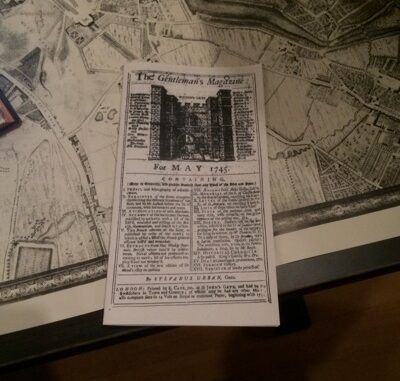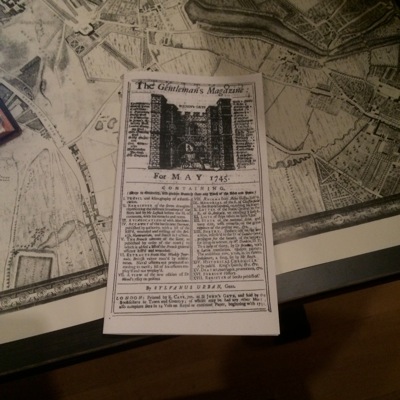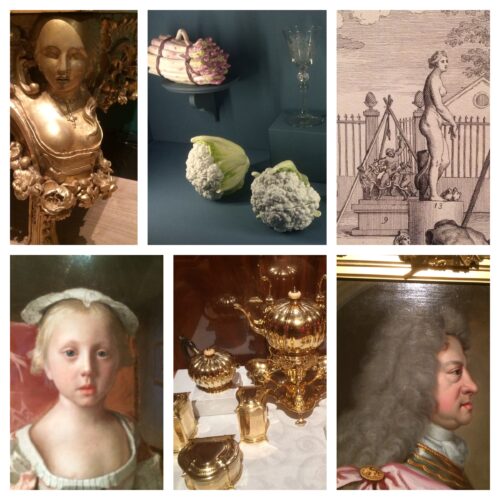
You’re probably getting used to hearing about the Georgians this year. If you’re not sure what all the fuss is about it’s easy to explain. 2014 marks 300 years since the Hanoverians were brought over from Germany and handed the English throne. A big anniversary for lovers of Georgian style, so expect a lot more talk of the Georges before New Year’s Eve rolls round again.
The latest show to take the Georgians as its theme is called The First Georgians: Art & Monarchy. This can be seen at the Queen’s Gallery at Buckingham Palace and shows works in fine and decorative arts from 1714 to 1760. All the work on display comes from the Royal Collection and includes portraits of the Kings and their families, architectural drawings of palaces as well as Old Master paintings they collected, contemporary works by artists such as Canaletto and decorative items such as tables, clocks and tea services that the monarchs would have used.

Facsimile of an early newspaper in the Learning room of the exhibition
Why was someone 50th in line to the throne sought out and offered the keys to England’s palaces?The catalyst was the childlessness of Queen Anne, combined with a little religious animosity. The heir by blood – which was how things were usually done – was James Stuart. He’d made the Crown-losing mistake of being a Catholic, and so Parliament searched through the Royal family tree to find someone, anyone, with a vague claim to being Royal and an unmistakable claim to being Protestant.
So it was that Anne’s second cousin George Ludwig upped sticks from Hanover where he’d been a relatively minor Elector and became King of England. Quite a promotion, even if the palaces over here were smaller and colder and everyone spoke a funny language called English.
The Georgians oversaw a period of great development in British culture. The country was experiencing liberty, prosperity and the benefits of free trade. It was the time of Newton and Locke and intellectual enlightenment. As we know from Jane Austen movies it was a time of elegance and politeness and aristocratic diving-into-ponds. But as this exhibition shows it was also a period of speculation, greed and poverty.
This latter quality of the period is best seen in the part of the exhibition devoted to Wm Hogarth. He had just begun his apprenticeship when George I came to the throne. Though he was not patronised by the Royal family he still achieved great success as an artist and writer on art. Two of his great satirical series are shown in full, reminding that not much has changed in the last three centuries – but there are also smaller pieces, such as his unflattering comparison of the proportions of actors David Garrick and James Quin.
Military maps show the Jacobite uprisings and one of the most interesting artefacts is a hand drawn plan of the battle of Culloden. It shows the last minute changes made to the line up of the British troops. Thought to be in the hand of the Duke of Cumberland it is a historical record of a period when members of the royal family still led troops into battle – George II being the last British monarch so to do.

A learning room imitates a Georgian coffee house and helps put the exhibition in context. You can flick through contemporary newspapers and wear tricorn hats with (probably not authentic) headphones attached to tell more of the Georgian tale. With architectural plans for palaces, views of London, Liotard pastels, a royal portraits and examples of decorative arts – asparagus tureen anyone? – there is a good selection of period pieces from the Royal Collection.
The Royal Collection is one of the largest and most important art collections in the world, with over a million objects. You won’t get to see them all in this show, but it gives an interesting overview of the Georgians themselves and the things they considered important and worth collecting. One room in particular is laid out as it would have been in the 18th century, with pictures symmetrically placed all over the walls, many in their original English Rococo frames. They hang amongst impressive furniture, clocks and table settings, all giving a sense of the range of styles and interests of early Georgian England.
Until October 12th 2014

Leave a Reply